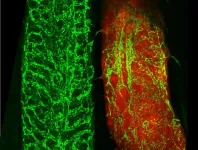(Press-News.org) Embargoed for release until 5:00 p.m. ET on Monday 28 October 2024
@Annalsofim
Below please find summaries of new articles that will be published in the next issue of Annals of Internal Medicine. The summaries are not intended to substitute for the full articles as a source of information. This information is under strict embargo and by taking it into possession, media representatives are committing to the terms of the embargo not only on their own behalf, but also on behalf of the organization they represent.
----------------------------
1. Up to half of Medicare beneficiaries lack financial resources to pay for a single hospital stay
Abstract: https://www.acpjournals.org/doi/10.7326/ANNALS-24-00787
URL goes live when the embargo lifts
A nationally representative study of Medicare beneficiaries with modest incomes found that up to half of them may not have sufficient funds to cover out-of-pocket costs associated with a single hospital stay. This financial precarity was more prevalent among Black and Hispanic beneficiaries, beneficiaries with lower levels of education, and those with multiple chronic conditions. The findings are published in Annals of Internal Medicine.
Researchers from the University of Pennsylvania Perelman School of Medicine used data from the 2018 wave of the Health and Retirement Study (HRS) to identify Medicare-enrolled respondents who would face financial precarity if exposed to the Medicare Part A hospital deductible of $1,600. The researchers focused on respondents making greater than 100% to 400% or less of the federal poverty level, or the so-called “economic middle” of Medicare recipients. This group includes people who earn too much to qualify for Medicaid but still may qualify for financial assistance in other programs. Financial precarity was defined as having insufficient funds to pay the Medicare hospital deductible and examined across 4 scenarios that considered checking and savings account balances, total liquid assets (with a reserve for future living costs), and supplemental insurance.
The researchers found that between 34.6% and 50.7% of the beneficiaries studied would face financial precarity if hospitalized because they would not have sufficient resources or supplemental insurance to cover associated out-of-pocket costs. While the prevalence of financial precarity varied by scenario, the proportion of beneficiaries who could not pay their hospital bill across all four scenarios exceeded 30%. Considering that just one hospitalization could deplete the financial resources of a large proportion of Medicare beneficiaries, these findings suggest a need to broaden financial protections for those with moderate incomes and limited assets.
Media contacts: For an embargoed PDF, please contact Angela Collom at acollom@acponline.org. To speak with corresponding author Paula Chatterjee, MD, MPH, please email pchat@pennmedicine.upenn.edu.
----------------------------
2. Novel blood-based screening for colorectal cancer less effective, less cost-effective compared to colonoscopies or stool tests
Abstract: https://www.acpjournals.org/doi/10.7326/ANNALS-24-00910
URL goes live when the embargo lifts
A projected impact and cost-effectiveness analysis estimated reductions in colorectal cancer (CRC) incidence and mortality with novel blood-based and stool-based CRC screening tests versus established alternatives. The results revealed that first-generation novel cell free blood DNA (cf-bDNA) tests have the potential to meaningfully decrease the incidence and mortality of CRC compared with no screening, but substantially less profoundly than colonoscopy or stool tests. The findings can inform the implementation of novel screening methods in clinical practice. This study is published in Annals of Internal Medicine.
Despite the emergence of multiple noninvasive screening methods, screening adherence among eligible people and follow up colonoscopy rates after an abnormal screen remain low. Researchers from Stanford University School of Medicine and colleagues used the Model of Screening and Surveillance for Colorectal Cancer (MOSIAC) to estimate the long-term clinical and economic impacts of novel CRC screening tests. The researchers compared CRC cases, CRC deaths, quality-adjusted life-years (QALYs), and costs among patients using established screening methods of fecal immunochemical tests (FIT), colonoscopies or multitarget stool DNA test (Exact Sciences Cologuard) vs. four emerging screening methods: two novel cell-free DNA blood tests (Guardant Shield and Freenome), an enhanced, next generation multitarget stool test, and a novel FIT-RNA test (Geneoscopy ColoSense). The researchers modeled idealized 100% adherence and colonoscopy completion after an abnormal noninvasive screening, as well as multiple dimensions of non-ideal participation in CRC screening. They also included the possibility of the blood test being taken by those who consistently declined colonoscopy or stool tests as well as substituting the blood test for other screening alternatives.
The researchers found that assuming 100% participation in all steps of screening, colonoscopy and FIT yielded reductions of more than 70% in CRC incidence and 75% in CRC mortality versus no screening. CRC incidence and mortality reductions were 68% and 73% with a multi-target stool DNA test, and similar rates were found for the enhanced multi-target stool DNA test and FIT-RNA test compared with no screening. The blood tests saw CRC incidence and mortality reductions of 42% and 56%. FIT and colonoscopy were more effective and less costly than blood and multi-target stool DNA tests, and the multi-target stool DNA test was more effective and less costly than the blood test. Participation rates through the various steps in the screening continuum substantially affected the estimated benefits. Achieving blood-based screening among persons unwilling or unable to undergo stool-based screening or colonoscopy improved population-level outcomes. However, substituting first generation blood-based screening in persons who would otherwise undergo stool-based screening or colonoscopy worsened population-level outcomes.
These findings suggest that consideration of all the attributes of novel screening methods, including performance and cost, and the need for colonoscopy follow-up after an abnormal noninvasive screening test must be emphasized when determining the best screening options in clinical settings.
Media contacts: For an embargoed PDF, please contact Angela Collom at acollom@acponline.org. To speak with corresponding author Uri Ladabaum, MD, MS please email Lorraine Benigno Ibana at libana12@stanford.edu.
----------------------------
3. Rosuvastatin associated with better cardiovascular and mortality benefits compared to atorvastatin
Abstract: https://www.acpjournals.org/doi/10.7326/M24-0178
URL goes live when the embargo lifts
A real-world study comparing the effectiveness and safety of rosuvastatin versus atorvastatin found that initiation of rosuvastatin treatment was associated with slightly lower risks of mortality, major adverse cardiovascular events (MACEs), and major adverse liver outcomes (MALOs). While the differences between treatments are relatively small, clinicians may want to consider these outcomes when prescribing one of these drugs to individual patients. The findings are published in Annals of Internal Medicine.
Researchers from Southern Medical University in Guangzhou, China studied data from 285,680 patients using the China Renal Data System (CRDS) and UK Biobank (UKB) databases to compare the real-world effectiveness and safety of rosuvastatin and atorvastatin. The researchers compared all-cause mortality, MACEs, MALOs, development of chronic kidney disease (CKD), development of type 2 diabetes mellitus (T2DM) and occurrence of other statin-related adverse effects between the two treatments using nationally available data. The researchers found that compared with atorvastatin initiation, participants with rosuvastatin initiation had lower risk for all-cause mortality, MACEs and MALOs, but no important differences were observed for risks for developing CKD and other statin-related adverse effects. In the UKB database, initiation of rosuvastatin led to a higher risk of T2DM compared to atorvastatin initiation. The results suggest that clinical outcomes associated with starting rosuvastatin differ from the outcomes associated with starting atorvastatin, and clinicians should consider these differences when prescribing to individual patients. However, many differences were relatively small and did not meet traditional standards for statistical significance, and further research is warranted to use these findings confidently in clinical practice.
Media contacts: For an embargoed PDF, please contact Angela Collom at acollom@acponline.org. To speak with corresponding authors Sheng Nie, MD, please email niesheng0202@126.com or Xin Xu, MD, PhD, please email xux007@163.com
----------------------------
4. VA and DoD publish revised headache treatment advice to include recently approved therapeutics
Abstract: https://www.acpjournals.org/doi/10.7326/ANNALS-24-00551
URL goes live when the embargo lifts
The U.S. Department of Veterans Affairs (VA) and U.S. Department of Defense (DoD) have updated their clinical practice guidelines for the management of headache to include several treatments recently approved by the U.S. Food and Drug Administration (FDA). The guidelines were revised earlier than the standard 5-year cycle due to the unprecedented expansion of headache medicine and therapeutics that took place since 2020 when the last guidelines were issued. A summary of these guidelines relevant to internal medicine physicians is published in Annals of Internal Medicine.
Researchers reviewed evidence from systematic reviews and studies published between 2019 and 2022 on the benefits and harms of drugs and nondrug options for the prevention and treatment of all types of headaches. The group considered the strength and quality of the evidence, input about value and care from a patient focus group and benefits versus harms on critical outcomes before making consensus recommendations. Since the last guideline update in 2020, two new classes of medications and several devices have been approved for headache indications by the FDA. The revised guidelines include 52 recommendations on evaluation, pharmacotherapy, invasive interventions, and nonpharmacologic interventions for selected primary and secondary headache disorders, including 17 new recommendations.
For acute migraines, primary care clinicians can consider triptans, aspirin-acetaminophen-caffeine, and newer CGRP inhibitors (gepants). To prevent episodic migraines, options include angiotensin-receptor blockers, lisinopril, topiramate, valproate, eptinezumab, and atogepant. AbobotulinumtoxinA is recommended for chronic migraines, but not for episodic migraines. Gabapentin is not recommended for episodic migraine prevention. Ibuprofen (400 mg) and acetaminophen (1000 mg) are suggested for treating tension-type headaches, with amitriptyline for chronic tension headache prevention. Aerobic exercise or physical therapy can also help manage tension headaches and migraines. Clinicians should work with their patients in crafting treatment plans that account for headache type or types, comorbid conditions, values and preferences.
Media contacts: For an embargoed PDF, please contact Angela Collom at acollom@acponline.org. To speak with corresponding author Jason J. Sico, MD, MHS, please email Jason.sico@va.gov.
----------------------------
Also new in this issue:
A New Horizon: The Promise of the National Institutes of Health’s Landmark Designation of Persons With Disabilities as a Population With Health Disparities
Shahin A. Saberi, BS; Angela Zhang, BA; and Dorothy W. Tolchin, MD, EdM
Ideas and Opinions
Abstract: https://www.acpjournals.org/doi/10.7326/ANNALS-24-00676
END
Up to half of Medicare beneficiaries lack financial resources to pay for a single hospital stay
2024-10-28
ELSE PRESS RELEASES FROM THIS DATE:
Chemicals produced by fires show potential to raise cancer risk
2024-10-28
Derek Urwin has a special stake in his work as a cancer control researcher. After undergraduate studies in applied mathematics at UCLA, he became a firefighter. His inspiration to launch a second career as a scientist was the loss of his brother, Isaac, who died of leukemia at only 33 despite no history of cancer in their family. Working with Anastassia Alexandrova, a professor of chemistry and biochemistry in the UCLA College, he earned his doctorate.
Urwin is now a UCLA adjunct professor of chemistry — and still a full-time firefighter with the Los Angeles County Fire Department. In a recent publication, his science shed new light on the chemical underpinnings of exposures ...
Penn Nursing awarded $3.2 million grant to improve firearm safety
2024-10-28
PHILADELPHIA (October 28, 2024) – The University of Pennsylvania School of Nursing (Penn Nursing) has been awarded a $3.2 million, 5-year grant from the National Institute of Nursing Research (NINR) to scale out an evidence-based secure firearm storage intervention at Children’s Hospital of Philadelphia (CHOP). Firearms are now the leading cause of death for U.S. children and teens, driving the largest spike in children’s mortality in more than 50 years. The study aims to keep children safer from firearm injury and mortality by promoting secure firearm storage.
The intervention, ...
Bird wings inspire new approach to flight safety
2024-10-28
Taking inspiration from bird feathers, Princeton engineers have found that adding rows of flaps to a remote-controlled aircraft’s wings improves flight performance and helps prevent stalling, a condition that can jeopardize a plane’s ability to stay aloft.
“These flaps can both help the plane avoid stall and make it easier to regain control when stall does occur,” said Aimy Wissa, assistant professor of mechanical and aerospace engineering and principal investigator of the study, published in the Proceedings ...
Global fleet of undersea robots reveal the phytoplankton hidden beneath the ocean's surface
2024-10-28
Marine phytoplankton are fundamental to Earth’s ecology and biogeochemistry. Our understanding of the large-scale dynamics of phytoplankton biomass has greatly benefited from, and is largely based on, satellite ocean color observations from which chlorophyll-a (Chla), a commonly used proxy for carbon biomass, can be estimated. However, ocean color satellites only measure a small portion of the surface ocean, meaning that subsurface phytoplankton biomass is not directly monitored. Chla is also an imperfect ...
Climate, dead zones and fish: Solving a 'wicked problem' in Lake Erie and beyond
2024-10-28
Images
There's a famous piece of advice from hockey, attributed to Wayne Gretzky, about how it's better to skate to where the puck is headed rather than where it is.
Research is now showing that regulations designed to protect Lake Erie's water quality are heeding the Great One's words when it comes to safeguarding the Great Lake's fisheries.
Specifically, the currently recommended limits on the flow of nutrients into Lake Erie from agriculture may be too restrictive for some species of fish. They are, however, suited to maintain healthy fisheries until the ...
Dinosaurs thrived after ice, not fire, says a new study of ancient volcanism
2024-10-28
201.6 million years ago, one of the Earth's five great mass extinctions took place, when three-quarters of all living species suddenly disappeared. The wipeout coincided with massive volcanic eruptions that split apart Pangaea, a giant continent then comprising almost all the planet's land. Millions of cubic miles of lava erupted over some 600,000 years, separating what are now the Americas, Europe and North Africa. It marked the end of the Triassic period and the beginning of the Jurassic, the period when dinosaurs arose to take the place of Triassic creatures and dominate the planet.
The exact mechanisms of the End Triassic Extinction have long been debated, ...
Green growth: 30% of regions worldwide achieve economic growth while reducing carbon emissions
2024-10-28
“We found that 30 percent of the regions with available data have fully decoupled carbon emissions from economic growth. Regions with high incomes and a history of carbon-intensive industries, as well as those with significant shares of service and manufacturing sectors were particularly successful in reducing carbon emissions while still experiencing economic growth,“ says Anders Levermann, co-author and head of the research department “Complexity Science” at PIK. “A stabilization of the global mean temperature is only possible with net-zero carbon emissions. That ...
Cellular couriers: Body's ‘delivery trucks’ could lead to new cancer blood test
2024-10-28
A landmark study led by WEHI and La Trobe University has found a potential new diagnostic marker that could be used to better detect the level of tissue damage in our bodies.
Extracellular vesicles (EVs) are small ‘delivery trucks’ released by our cells that deliver important materials to other cells to aid cellular communication. This study revealed, for the first time, a link between levels of EVs in the blood and tissue damage caused by diseases such as leukaemia.
Researchers hope to leverage the ...
Public and community engagement key to enhancing urban living conditions and environmental decision making in China, study says
2024-10-28
Public and community engagement in decision making is key to enhancing urban living conditions and the environment in China, a new study says.
There has been significant progress through legislation to promote the role of citizens in environment and nature-based solutions (NBS), but progress in involving the public in projects has been limited, the research shows.
However, there has been some work in gathering public opinion and involving them in the project design and decision-making of government-led and large NBS projects.
Researchers found smaller local NBS projects tend to see higher levels of public participation, ...
Bagheri to leverage recycled polyurethane foam for real-world applications
2024-10-28
Bagheri To Leverage Recycled Polyurethane Foam For Real-World Applications Shaghayegh Bagheri, Assistant Professor, Mechanical Engineering, College of Engineering and Computing (CEC), received funding for the project: “Leveraging Recycled Polyurethane Foam for Real-world Applications.”
Bagheri ...





